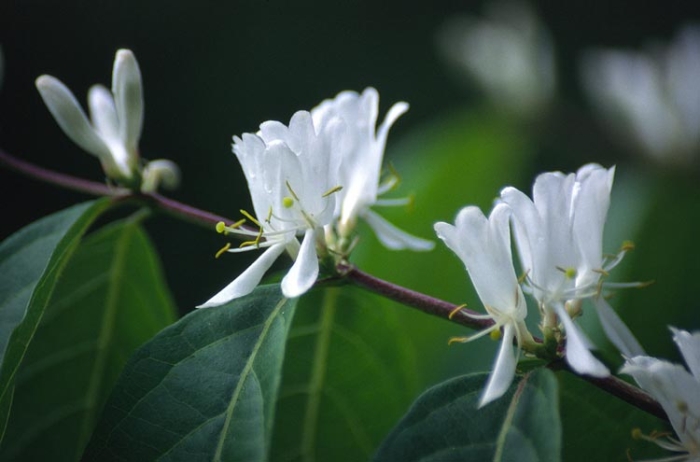Amur Honeysuckle
(Lonicera maackii)
Amur Honeysuckle (Lonicera maackii)
/
/

Dr. Nick V. Kurzenko
Public Domain
Image By:
Dr. Nick V. Kurzenko
Recorded By:
Copyright:
Public Domain
Copyright Notice:
Photo by: Dr. Nick V. Kurzenko | License Type: Public Domain | License URL: http://creativecommons.org/licenses/publicdomain/ | Attribution: 2002 Nick Kurzenko | Publisher: Calphotos |
































































Estimated Native Range
Summary
Lonicera maackii, commonly known as Amur Honeysuckle, is a deciduous shrub originating from riparian zones, forest edges, and open woodlands in East Asia, particularly in regions of China, Korea, and Japan. It can grow up to 6 meters (20 ft) tall with stems reaching 10 centimeters (4 in) in diameter. This species is characterized by its arching branches, oval leaves, and tubular flowers that are creamy white to yellow, turning yellow-orange to pink with age. The flowers are highly fragrant, blooming from late spring to early summer, and are followed by bright red to black berries that ripen in autumn. The berries are semi-translucent, 2–6 millimeters in diameter, and contain numerous small seeds that are dispersed by birds.
Amur Honeysuckle is valued for its vigorous growth, ease of maintenance, and the ornamental quality of its flowers and berries. It is often used in urban and residential settings for hedges, screens, and wildlife gardens. The plant is adaptable to a variety of conditions, but it thrives in full sun to part shade with medium water requirements and can tolerate a range of soil types with varying drainage. Popular cultivars include "Erubescens" with pink flowers and "Rem Red" with an erect form. However, it can be invasive, outcompeting native species and disrupting local ecosystems. It is also susceptible to powdery mildew and honeysuckle aphids. In areas where it is invasive, it is recommended to consider native alternatives or manage its spread responsibly.CC BY-SA 4.0
Amur Honeysuckle is valued for its vigorous growth, ease of maintenance, and the ornamental quality of its flowers and berries. It is often used in urban and residential settings for hedges, screens, and wildlife gardens. The plant is adaptable to a variety of conditions, but it thrives in full sun to part shade with medium water requirements and can tolerate a range of soil types with varying drainage. Popular cultivars include "Erubescens" with pink flowers and "Rem Red" with an erect form. However, it can be invasive, outcompeting native species and disrupting local ecosystems. It is also susceptible to powdery mildew and honeysuckle aphids. In areas where it is invasive, it is recommended to consider native alternatives or manage its spread responsibly.CC BY-SA 4.0
Plant Description
- Plant Type: Shrub
- Height: 14-20 feet
- Width: 10-15 feet
- Growth Rate: Moderate
- Flower Color: Yellow, White
- Flowering Season: Spring
- Leaf Retention: Deciduous
Growth Requirements
- Sun: Full Sun, Part Shade
- Water: Medium
- Drainage: Fast, Medium, Slow
Common Uses
Bee Garden, Bird Garden, Butterfly Garden, Erosion Control, Fragrant, Hummingbird Garden, Showy Flowers
Natural Habitat
Originates from riparian zones, forest edges, and open woodlands in East Asia
Other Names
Common Names: Bush Honeysuckle, Koreatry
Scientific Names: , Lonicera maackii, Lonicera maackii f. podocarpa, Lonicera maackii var. maackii, Caprifolium maackii, Xylosteon maackii, Xylosteum maackii,
GBIF Accepted Name: Lonicera maackii (Rupr.) Maxim.